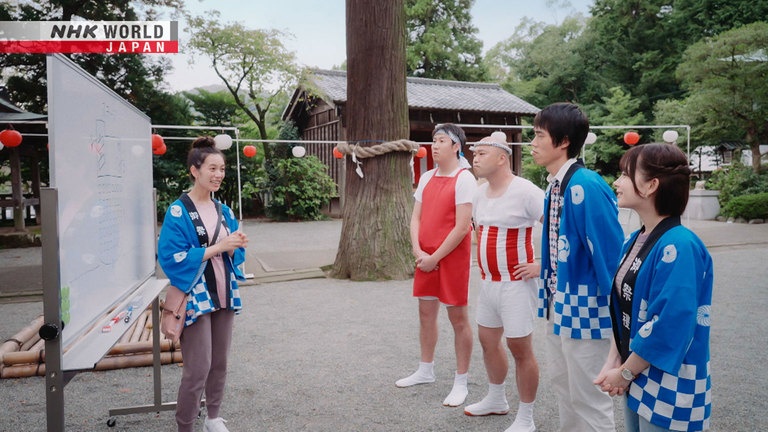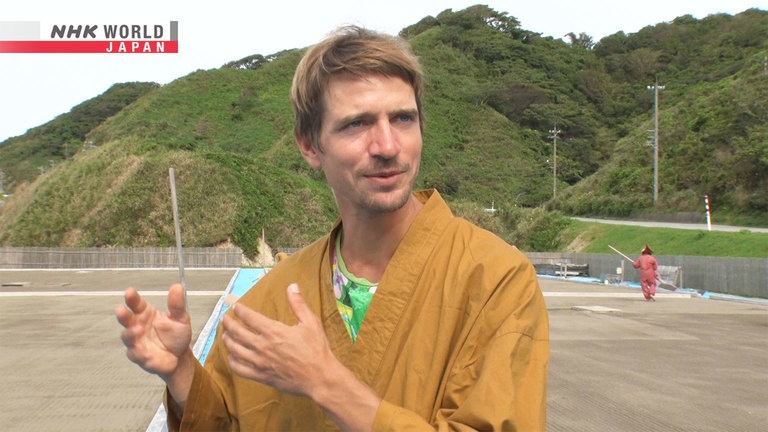#21 I Can Use That!
Drama "Xuan Tackles Japan!"
Three days before the summer festival, Xuan is at the shrine grounds preparing the stage with Danny, Monica, Aoi and other locals. After Tadokoro leaves them with convoluted instructions, everyone is confused about how the chairs and tables should be arranged. Xuan tries to find Tadokoro, but Yansu reminds her that she should be able to explain. Xuan comes round to the idea of explaining the layout to everyone herself. But the information is complicated. How can she explain it in an easy-to-understand manner?
"Onomatopoeia" -Share Feelings- Texture of Food 1
"Welcome to My Japan!" focuses on the life of Romain LEBRUN from Belgium, who works as a salt master at a salt farm in Ishikawa Prefecture!




Transcript
Activate Your Japanese!
What would you do
if you were Xuan?
"Three days to the festival."
Now let's set up the stage.
Ono-san and Senba-san
will be helping us today.
- Hi!
- Let's make it a great festival.
Yes, let's.
Like I explained to you two yesterday,
let's do the chairs for the audience first.
Five rows of eight chairs.
And we need tables on stage.
One on the right
and two on the left.
Put the prizes on the right table,
and the left tables will need chairs.
And what else...?
Keep the microphone to the side
so it doesn't get knocked over.
Where's the mortar and mallet?
We're not making mochi rice cakes.
What?!
That's not good!
These two think that
mochi-making is a must.
We're not making mochi?
Tadokoro-san,
we need to make mochi at a festival!
What fun is a festival without it?
Calm down.
It'll be fun even without making mochi.
The festival masks are here.
I'll be right there.
Could you start setting
the stage without me?
Okay.
Aoi-chan, come with me.
Okay.
Thanks, everyone!
Okay, let's start.
How many tables do we need on stage?
- Eight? Or is it five?
- That's the number of chairs.
But can we have so many chairs on stage?
One, two, three... I guess not.
Um...
It's eight, five, one and two.
Which number's for what?
Xuan-san!
What's wrong?
How many tables on stage?
Um...
One table on the right-hand side and two on the left.
- Then one over here.
- Isn't it the other side?
"Right" should be from
the audience's point of view.
- No, it's facing the audience.
- Really?
Which is it?
Um...
Xuan-san...
What do we do with the microphone?
I think he said to put it somewhere because we don't want to knock it over.
Where should it go?
Where...?
Um...
I'm sorry.
I'll get someone who can explain.
Maybe we should have a mortar and mallet
ready on the day, just in case.
Yeah, you're right.
Maybe not.
I thought it was your day off.
It is. But Xuan asked me to...
Ah, the festival?
Yes.
I see. That's great!
But it's not that simple.
This is for the festival?
That's right.
They're beautiful,
but how will you serve them?
I have an idea,
but I'm not sure it'll work.
Oh no!
Where's Tadokoro-san?
What are you wandering around for?
Yansu, I'm looking for Tadokoro-san.
Maybe explaining it yourself would be
quicker than trying to find him.
You're not being very helpful.
Don't you know what should be done?
I do, but...
You heard the plans yesterday,
didn't you?
Mm-hmm.
Then you should be able to
explain it to everyone.
But it's difficult to explain.
It's difficult because you're trying to
explain just with words.
There's always other ways too.
Other ways? Like what?
Well...
You could try using that.
I get it!
I knew I could count on you.
I hope this explains it better.
It should look like this.
Wow, you drew all that?
Yes.
Here's how it is.
For the audience,
eight chairs per row, five rows.
So eight and five are
numbers for the chairs.
And the stage?
For the stage, we need one table
over here and two over there.
I see. So it's one over there.
Put the prizes on the table on the right.
The tables on the left need chairs.
This, I can understand.
So true.
I'm glad.
Let's set the chairs for the audience.
All right. Let's carry the tables!
I'll get this end.
One, two... and three!
What's wrong?
Ono-san looks strong,
but he actually has a bad back.
I'll carry the heavy stuff.
Thank you, Xuan-chan.
My foot hurts!
Huh? Seriously?
Come on. Hurry up.
Let's do this.
Rei-san...
This must be...
"Monaka-zushi"?
Wow! They're so pretty!
"Using diagrams and pictures can
make it easier to communicate."
"And now that I know how hard
Rei-san's been working," "I'm going to do my best too!"
"Today's Strategy!"
Now, when someone tries to explain
layouts or routes only with words, it can be confusing
and difficult to understand.
So you want to explain it better.
What will you do if that happens?
Let's look at the strategy Xuan used.
It should look like this.
For the stage, we need one table
over here and two over there.
"Explain with illustrations."
It can be hard to image a layout,
if it's explained only with words.
But if you explain with a diagram
like Xuan did, it'll be easier to understand.
Photos can help too, depending on
what you're trying to explain.
Get creative in how you
present information.
Goodbye for now.
Meet senpai from all over Japan.
Tsutsu Uraura!
Let's hear about their lives.
Today's senpai is Romain Lebrun from Belgium.
Wajima, Ishikawa.
For more than 400 years, salt has been made here.
Romain carries on the tradition.
Using old methods to make natural
salt is a source of pride.
To make salt, sea water is tossed over sand and dried under the sun.
The salt rises to the surface.
Then the sand is gathered.
Sea water is washed over this sand to produce a highly salty water.
After simmering for 16 hours, the salt is ready.
It's ten times the price of factory-made salt.
The salt is prized by luxury restaurants for its culinary value.
It's very salty.
It has lots of minerals, so it
makes cooking taste great.
Romain fell in love with the scenery of Japan through movies.
At 27, he studied at a language school in Kyoto.
After half a year, he began working at a hotel.
On days off, he would travel the countryside by bike.
It was then that he encountered Wajima and just loved its beauty.
He moved here in 2019.
He initially worked at a hotel, but out of a desire to work in nature, he began making salt.
Bonds with nature have been part of
the culture for hundreds of years.
I want to share that with
people from abroad.
Hello. Welcome.
Back in the days, we had these tools here.
If you want to try it...
Romain speaks English, French, Spanish, and Japanese.
He helps guide visitors.
He interprets, and guides people.
It's a big help.
Romain lives in Wajima, Ishikawa.
He bought a home for a low price and grows his own vegetables.
Surrounded by nature, Wajima's key industry is fishing.
Romain loves to eat sushi made with local seafood.
― Here you are.
ーThank you.
His favorite is octopus.
I like the texture of the suckers.
I'll eat slowly and relax.
Romain has a hobby he's passionate about.
Wadaiko drums are a big part of local festivals.
The movements and everything
are so cool.
Romain gives it his all.
It teaches and inspires me.
Thank you.
Thank you.
Here's how Romain learns kanji.
Each kanji has multiple parts.
I learn simple kanji.
And when I see them used as parts,
I can guess the meaning.
This kanji contains kuruma: car.
Romain uses that as a clue to the reading and meaning.
He avoids using a dictionary right away, and instead makes a guess.
I'm often wrong.
But being wrong helps me remember.
I think, "Oh, that's what it
means!" and it sticks in my head.
Here are Romain's favorite words.
Hearts together as one.
Feeling what others feel,
and feeling together with them.
With the salt fields and with
taiko, I work together with others.
Romain's dream is to bring even more foreign tourists to Wajima.
Good luck, Romain!